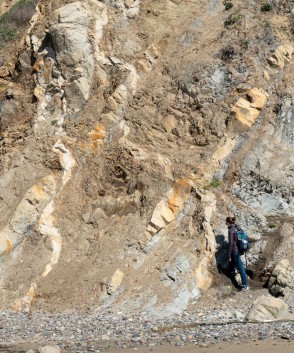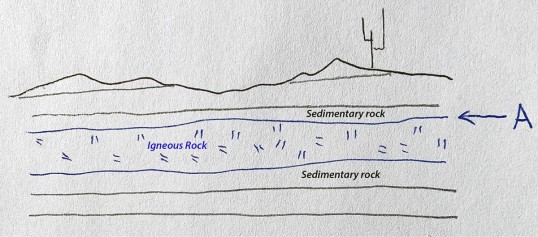Where rocks touch: geologic contacts
Geologic contacts are the surfaces where two different rocks touch each other –where they make contact. And there are only three types: depositional, intrusive, or fault. Contacts are one of the basic concerns in field geology and in creating geologic maps –and geologic maps are critical to comprehending the geology of a given area. For those of you out there who already know this stuff, I’ll do my best to spice it up with some nice photos. For those of you who don’t? This post is for you!
Depositional contacts are those where a sedimentary or volcanic rock was deposited on an older rock (of any type). Intrusive contacts are those where igneous rocks intrude older rock (of any type). Fault contacts are… faults! –surfaces where two rocks of any type have moved into their current positions next to each other along a fault.
In a cross-sectional sketch they may look like this:
And here are some photos. Click on the image to see it at full size.
So how do you tell them apart in the field? If the actual contact surface isn’t exposed –which is usually the case– you have to use some indirect observations. Here are some general rules that can help. Of course, each “rule” has exceptions, described later.
Intrusive Contacts. To be intrusive, the contact should involve intrusive igneous rock that is younger than the rock it’s contacting (the country rock). You might see evidence of heating in the country rock like in the photo below, or a chilled margin along the outer edge of the intrusion, illustrated by the next photo.

Basaltic dike intruding volcanic mudflow deposits, eastern Oregon. Note the baked and altered edge of the country rock.
And here’s what a chilled margin looks like. The crystals in the intrusive rock (dark green diabase) decrease in size towards the margin because it cooled faster than the interior.
Fault Contacts. For a fault, you should see features on either side being cut off by the contact. And up close, you can look for indications of movement, like polished fault surfaces, intensive fracturing, or fragmented rock along the contact.

Normal fault placing thick-bedded Wingate Sandstone (left) against thin-bedded Kayenta Formation (right), SE Utah.
Depositional Contacts. If it’s depositional, you should observe that bedding in the overlying younger rocks is parallel to the contact (they were deposited on it).

The dashed line marks a depositional contact in the Grand Canyon. Note how the overlying bedding is parallel to the contact. They’re also parallel to each other, to suggest they’re depositional as well!
There are myriad other features that can help, like hydrothermal alteration along fault or intrusive contacts, or local erosional scours along depositional ones. Here’s a photo of a fault zone, with chemical alteration expressed as the yellow and red colors, brecciation of the host rock, and several small fault surfaces. The fault surface just right of the pocket knife displays striations that formed parallel to slip along the fault.
The list below lays out some of the more important features found along different contacts.
Some Exceptions
And here are two notable exceptions to the general rules above!
1) Intrusive contacts should involve igneous rock. Actually… sometimes, non-igneous material can become mobilized and intrude fractures dikes. The most common example is that of wet sand that’s under pressure and injects into cracks to form sandstone dikes, like the photo below. However, I’ve also seen marble, deformed at high temperatures, intrude cracks as well.
In this photo on the left, the bedding is dipping steeply to the left whereas the sandstone dikes are cutting across the bedding at high angles. Both the dikes have highly irregular shapes. Click on the photo to see it at full size.
2) Along depositional contacts, the younger sedimentary rock should be parallel to the contact. However, in some continental settings, such as canyons or deep river valleys, sediment can get deposited against the steep edge of canyon or valley. A sketch would look like this:
And a photo like this:

The dashed line marks a depositional contact that cuts the bedding in the younger sedimentary rock, a buttress unconformity.
Unconformities
In the sketch and photo above, notice that there’s a demonstrable gap in the rock record between the two rocks because the rock of the canyon walls had to form and be eroded before the new sediment filled it up. Any depositional surface across which there is a gap in the rock record is called an unconformity. This particular unconformity, because the younger rock is deposited against a buttress, is called a buttress unconformity.
There are three other types of unconformity: angular unconformity, nonconformity, and disconformity. Please see my post and photos for more details about unconformities in the Grand Canyon –but basically, angular unconformities are those in which there’s an angular relation between the bedding above and below the contact; nonconformities are those between sedimentary or volcanic rocks above intrusive igneous or metamorphic rocks; disconformities are between parallel sedimentary rocks. They’re illustrated below with a diagram I grabbed from that earlier post.

Unconformities in the Grand Canyon. D: Disconformity; A: Angular Unconformity; N: Nonconformity (from earlier post on unconformities in the Grand Canyon)
And why is all this important?
Our interpretation of geologic contacts completely determines our view of an area’s geology. For example, the contact labeled “A” in the sketch below could be either depositional or intrusive. If it’s depositional, the overlying sedimentary rock is younger than the igneous rock. If it’s intrusive, the overlying sedimentary rock is older!
If you don’t believe those issues arise, here’s a series of photos of the Purcell Sill in Glacier National Park, Montana. Each successive photo is a closeup of the square area in the previous one. You can click on the series to see it at full size.
How can we tell that it’s a sill and not a volcanic layer that’s younger than the overlying rock? The first two photos show a lot of bleaching of the surrounding rock on either side of it, suggestive of high temperatures –and the third photo shows that the rock is coarsely crystalline, typical of intrusive igneous rocks rather than volcanic ones. And in many other places, you can see the sill cutting across layering at a low angle.
So Contacts… yes! –the important first step in reading geologic maps (get ready for a post on reading geologic maps in the coming weeks). And if you’d like to use any of these photos, they’re all freely downloadable for non-commercial use from my website –just go to the geology photo search page and come up with some key words!


Thanks, Marli. As always, informative and delightful. I’m re-blogging this, citing my own blog posts about the famous unconformity at Siccar Point, and the depositional contact at the Giants Causeway between a later lava flow, and the paleosol formed by weathering of the one before it: https://paulbraterman.wordpress.com/2014/11/16/time-turned-to-stone-part-1-time-as-interval/ and https://paulbraterman.wordpress.com/2014/12/14/time-turned-to-stone-part-2-the-giants-causeway-time-as-process/
LikeLike
Thanks Paul! And I’ll look forward to checking out your links!
LikeLike
Pingback: Touring the geologic map of the United States | geologictimepics
Really gives a variety of information a geologist needs about geologic contacts in a geologic field mapping.
LikeLike